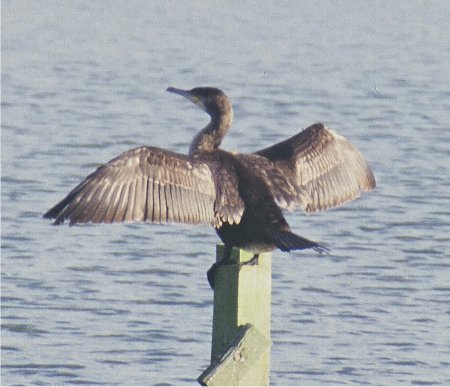|
GreenPlaces
|
|
Wildlife and conservation news from around the U.K. |
|
Menu
|
 |
|
||||||
|
The number of Cormorants (Phalacrocorax carbo) that can be killed has been increased from 500 to 3,000 per year, for at least the first two years of the scheme. This increase means that 20% of the English Cormorant population can legally be shot each year. The changes to the scheme are in response to anglers and fisheries owners who claim that the Cormorant is damaging UK fish stocks. Cormorants are included on the Amber list of Birds of Conservation Concern. Their breeding population is concentrated on relatively few sites, and the UK supports over 20% of the European wintering population.
The RSPB says that the new system is intended to reduce the Cormorant population, instead of protecting fish stocks. Whereas under the present system, licences are only issued to "shoot to scare" Cormorants from the few fisheries where serious damage has occurred and the person seeking the licence has to demonstrate that non-lethal measures have failed. The new system assumes that where there are significant numbers of Cormorants that are feeding on fish stocks, serious damage is occurring or will occur. This means that, for the first time, owners of fisheries will not have to demonstrate that Cormorants are damaging their stocks before applying for a license. Cormorants can cause damage to other fish whilst fishing, especially larger ones which they can't grab properly. This may increase the risk of disease and stress in the fish population of a water body and therefore increase mortality. Fishes behaviour may be changed, making them more difficult to catch, resulting in the perception that there are fewer fish. However, the number of Cormorants at a particular site is self regulatory as they respond to the numbers of fish rather than limit the fish stocks. Shooting Cormorants to scare them away from an area can work, but the success varies. At some sites, shooting, to kill or to scare, seems to have little effect on the number of Cormorants present. At other sites, birds leave for a short while but soon return. Killing Cormorants will only serve to create a "vacuum", for example, during the winter of 1996/1997 about 6,000 Cormorants were shot in Bavaria - the entire wintering population. However, the average winter population was not reduced; culling the birds only created a space that others moved into from surrounding areas. To make any difference to the Cormorant population, it is estimated that 30,000-60,000 Cormorants would have to be killed every year throughout Europe. Dr Mark Avery, Director of Conservation at the RSPB, said: "This snap decision by the minister ignores the advice of his own scientists and caves in to pressure from anglers. We believe that this shoot to kill policy is contrary to bird conservation law and we are determined to get the decision reversed. "The government's own research shows that Cormorants have a negligible impact on fish populations nationally and that any local problems can be reduced by non lethal means. Studies commissioned by DEFRA on fish shelters on still water fisheries shows these refuges can reduce Cormorant predation by up to 86%. "The new policy will simply not work; other Cormorants will replace those killed. Making sites unattractive to Cormorants or scaring then off are much more effective means of reducing any impact on fisheries." The RSPB has sought legal advice on the action it can take to force government to reverse its decision, and a 'letter before claim' to quash the decision will be issued to government shortly. Ben Bradshaw said, "For a long time, DEFRA has accepted that Cormorants can and do cause damage to certain habitats. To help solve this problem we have undertaken scientific research into fish refuges and other non-lethal techniques. Research findings to date show that procedures such as creating safe environments for fish from Cormorant predation are not the solution to all problems." DEFRA say that each licence application will be dealt with individually and non-lethal solutions will have to be considered first. All new applications will require an inspection from a DEFRA assessor, and each site covered by a licence will be visited for2 years. All licence holders must provide annual returns on the actual number of Cormorants taken, and if they don't their licence will be revoked. |
|
|
Links |
|
|
RSBP website |
|
|
DEFRA website |
|
|
Images |
|
|
Cormorant drying its wings, Titchfield Haven, Hampshire., 1999, Paul Glendell - English Nature |
|

 There are an estimated 17,000 resident Cormorants in the UK and 6,000 visit this country in winter. The population has increased significantly since the 1980s, when populations were mostly confined to coasts and estuaries. A major factor for this increase is that the population has responded to an increase in artificially stocked water bodies, the creation of reservoirs and gravel quarries and the improvement in the water quality of rivers and lakes.
There are an estimated 17,000 resident Cormorants in the UK and 6,000 visit this country in winter. The population has increased significantly since the 1980s, when populations were mostly confined to coasts and estuaries. A major factor for this increase is that the population has responded to an increase in artificially stocked water bodies, the creation of reservoirs and gravel quarries and the improvement in the water quality of rivers and lakes.